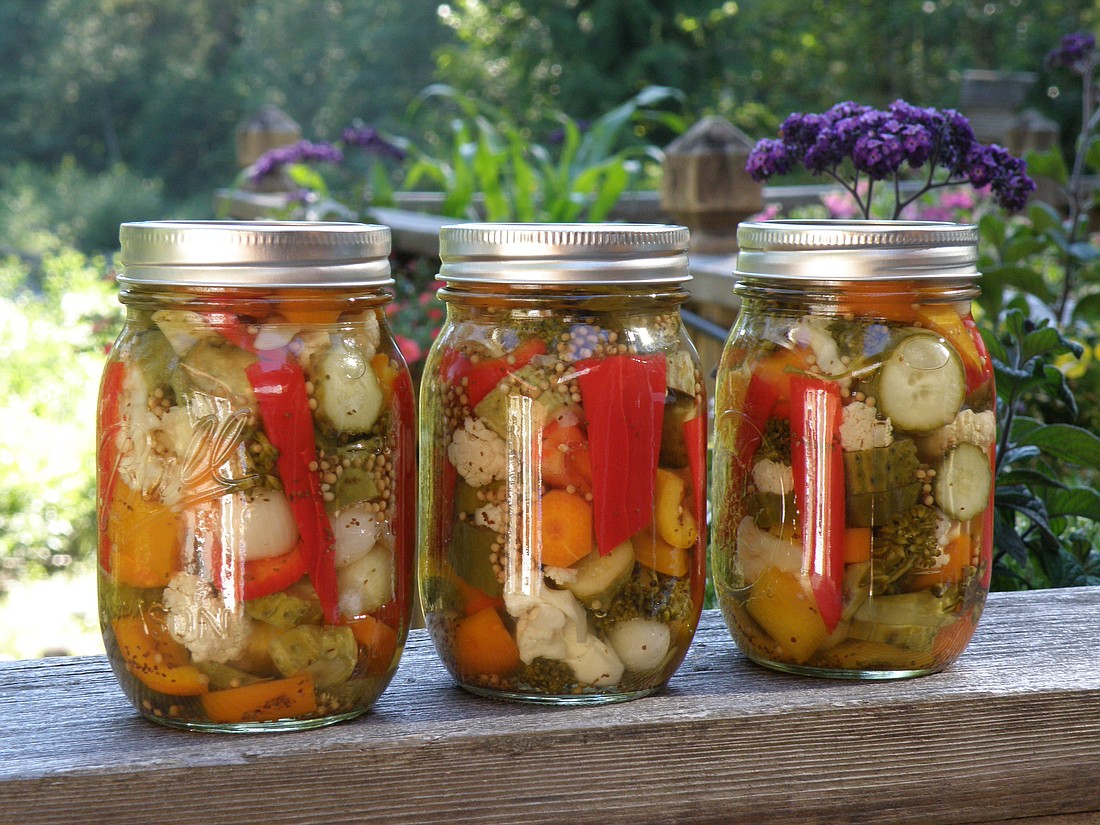In a pickle? Salt-free ways to preserve veggies
December 2, 2015 at 11:01 a.m.
Waiting for spring and the return of local veggies to your plate can be hard. But there is hope! Pickled veggies are delicious and not hard to make. I recall and really appreciate what my grandmother did with beets in the winter. She pickled them. Pickling without salt is a great way to add new flavor to veggies that you may be getting tired of. It almost makes them a new food.
Pickled vegetables are found around the world: greens in China, Japan’s daikon, Indian vegetables with curry spices, Mediterranean turnips and lemons, and even Italian mixed vegetables and garlic. Home-pickled vegetables may sound salty, but it is vinegar that “quick pickles” vegetables, not salt. And that’s great news because salt is hard on your blood vessels, hearts and kidneys. So, leave out the salt, add some inventive seasonings, and capture that fresh food taste until spring greens arrive.
You can use this quick pickle technique with most vegetables. Try white or red wine vinegar, or my favorite - champagne vinegar - for a milder, less astringent flavor. Pickled vegetables make great appetizers or accompaniments to meat and chicken dishes. They’re also great on salads and in sandwiches or burgers. They complement any meal because they use flavors besides salt – sour, sweet and bitter.
You can quick pickle just one or two jars (they don’t have to be canning jars) of vegetables. You don’t need any special equipment, and you can have great additions to meals for several months, as long as you keep them refrigerated.
Nana’s Pickled Beets
Slice these and serve over lettuce with crumbled blue cheese and pecans for a great salad. These beets keep for two months refrigerated.
4-5 medium beets
1 cup cider vinegar
4 tablespoons sugar
4 tablespoons whole allspice
¼ cup fresh basil or 2 tablespoons dried
Put beets in bowl and microwave 10 to 15 minutes, until tender. Remove skins. Chop into bite-size pieces or slices. Mix all other ingredients and microwave five minutes. Pour over beets, add basil, and let rest 30 minutes. You can serve over salads, or as an accompaniment.
Nutrition Information per ½ cup:
Calories: 22
Carbohydrates: 5 g
Protein: 0 g
Sodium: 14 mg
Mexican Pickled Carrots
Add these traditional spicy hot carrots to tacos, or put in a taco salad. Use gloves when working with jalapeño peppers, or strip the seeds out under running water.
1/4 cup vegetable oil
3 cups cider vinegar
1 teaspoon ground cumin
1 teaspoon oregano
1 teaspoon black pepper
1 tablespoon chili flakes (optional)
1 tablespoon mustard seed
1 pound carrots cut into thin rounds
1/4 cup thinly sliced onion
3 whole garlic cloves
1 jalapeño, sliced, seeds removed.
Bring vinegar, vegetable oil, and chili flakes to a boil in large pan. Reduce heat to medium and simmer about five minutes. Add spices and cook another five minutes. Add carrots and remaining ingredients, and cook about 10 more minutes. Cool and then refrigerate. Keeps for one month refrigerated.
Nutrition Information per ½ cup:
Calories: 45
Carbohydrates: 3 g
Protein: 0 g
Sodium: 20 mg
Italian Pickled Vegetables
The Italians call these mixed pickled vegetables giardiniera. You can chop them very fine in a food processor or blender, mix with mayonnaise, and serve on top of toasted French bread as a wonderful appetizer.
2 cups white, red wine or champagne vinegar
2 tablespoons sugar
10 cloves sliced garlic
1 small onion, sliced thinly
2 cups cauliflower, broken into segments
2 cups sliced zucchini or summer squash
4 stalks celery
2 carrots, sliced thinly
2 cups green beans, fresh or frozen
1 tablespoon whole pepper
Put all vegetables in a glass jar or bowl. Add vinegar and spices. Refrigerate 8-12 hours before serving. Keeps for one month refrigerated. Once the vegetables are gone, use the vinegar mixture as a meat or poultry marinade.
Nutrition Information per ½ cup:
Calories: 26
Carbohydrates: 6 g
Protein: 1 g
Sodium: 24 mg
The information in this column is meant for people who want to keep their kidneys healthy and blood pressure down by following a low-sodium diet. In most cases, except for dialysis patients, a diet high in potassium is thought to help lower high blood pressure. These recipes are not intended for people on dialysis without the supervision of a registered dietitian.
[Katy G. Wilkens is a registered dietitian and department head at Northwest Kidney Centers. The 2014 recipient of National Kidney Foundation Council on Renal Nutrition’s Susan Knapp Excellence in Education Award, she has a Master of Science degree in nutritional sciences from the University of Washington. See more of her recipes at www.nwkidney.org.]





